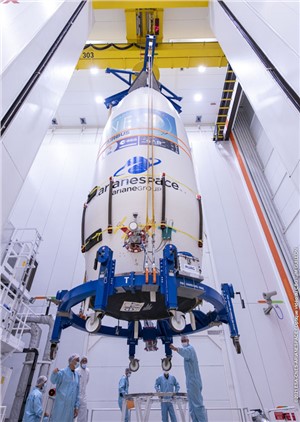Vega Mission to Orbit Airbus' Pleiades Neo 4 Earth Observation Satellite Alongside Four Scientific Auxiliary Spacecraft
August 11, 2021
-On Monday, August 16, 2021 at 10:47 pm local time (01:47 am (UTC) on Tuesday, August 17), Arianespace’s second Vega mission of the year will lift off from Europe’s Spaceport in French Guiana, with the optical observation satellite Pléiades Neo 4 and four auxiliary passengers.
After liftoff from Europe’s Spaceport, the Vega launcher will fly for a little over six minutes, powered by the first three stages. The third stage will then separate from the upper composite, which comprises the AVUM upper stage, the Pléiades Neo 4 satellite and its four auxiliary passengers. The AVUM stage will ignite its engine for the first time, in a powered phase lasting about eight minutes, followed by a ballistic phase lasting over 37 minutes. The AVUM stage will then restart its engine for a second burn lasting a little minute, before releasing the Pléiades Neo 4 satellite at an altitude of 625 km. The next two AVUM ignition phases will last 14 and 13 seconds interrupted by a 41 minutes lasting ballistic phase, followed by the release of the four auxiliary payloads. That will mark the end of mission VV19, one hour and 44 minutes and 59 seconds after liftoff.
Pléiades Neo 4, fully funded and manufactured by its operator Airbus, is the second out of four satellites of Pléiades Neo constellation, the first one having been successfully orbited by Vega Flight 18 on April 28, 2021. With 30cm-native-resolution, best-in-class geolocation accuracy and twice-a-day revisit, the four Pléiades Neo satellites unlock new possibilities with ultimate reactivity. Thanks to these state-of-the-art satellites, each step of the acquisition and delivery cycle offers top-level Earth observation services now and going forward for the next ten years.
The 19th mission of Europe’s Vega light launcher will also orbit three cubesats for the European Space Agency (ESA):
- LEDSAT, an educational project from the University of Sapienza participating in ESA’s Fly Your Satellite! program, that has been conceived to investigate the performances of a technology based on Light Emitting Diodes for the optical stand-alone Low-Earth Orbit satellites tracking;
- RADCUBE, a CubeSat developed with an international consortium to demonstrate miniaturized instrument technologies that measure in-situ the space radiation and magnetic field environment in Low Earth Orbit for space weather monitoring purposes;
- SUNSTORM, a cubesat with an innovative solar X-ray spectrometer to detect the X-ray pulses produced by coronal mass ejections – massive eruptions of many millions of tons of material from the Sun’s surface.
The last satellite onboard Flight VV19 will be BRO-4, a CubeSat developed by the French start-up Unseenlabs. The spacecraft is part of the constellation BRO (Breizh Reconnaissance Orbiter), a spectrum monitoring and electromagnetic intelligence service for maritime surveillance. The auxiliary payloads are under contract of SAB Launch Services.
As demonstrated by this new mission, Vega is perfectly suited to both commercial and government payloads. Because of its high performance and versatility, Vega provides the best possible launch solution for small and medium spacecraft headed into a wide range of orbits (Sun-synchronous, ballistic, transfer to the Lagrange point L1, etc.), for Earth observation, science, education, defense and other applications.
The Vega program is the result of the cooperation of 10 European countries. It has been developed under the leadership of ESA, with Italy (ASI) as the first contributor and Avio Spa (Colleferro, Italy) as a prime contractor, responsible for all industrial operations up-to lift-off from Europe’s Spaceport. Since its maiden flight in 2012, Vega is part of the family of launchers exploited by Arianespace.
Source : Arianespace

Related Studies


